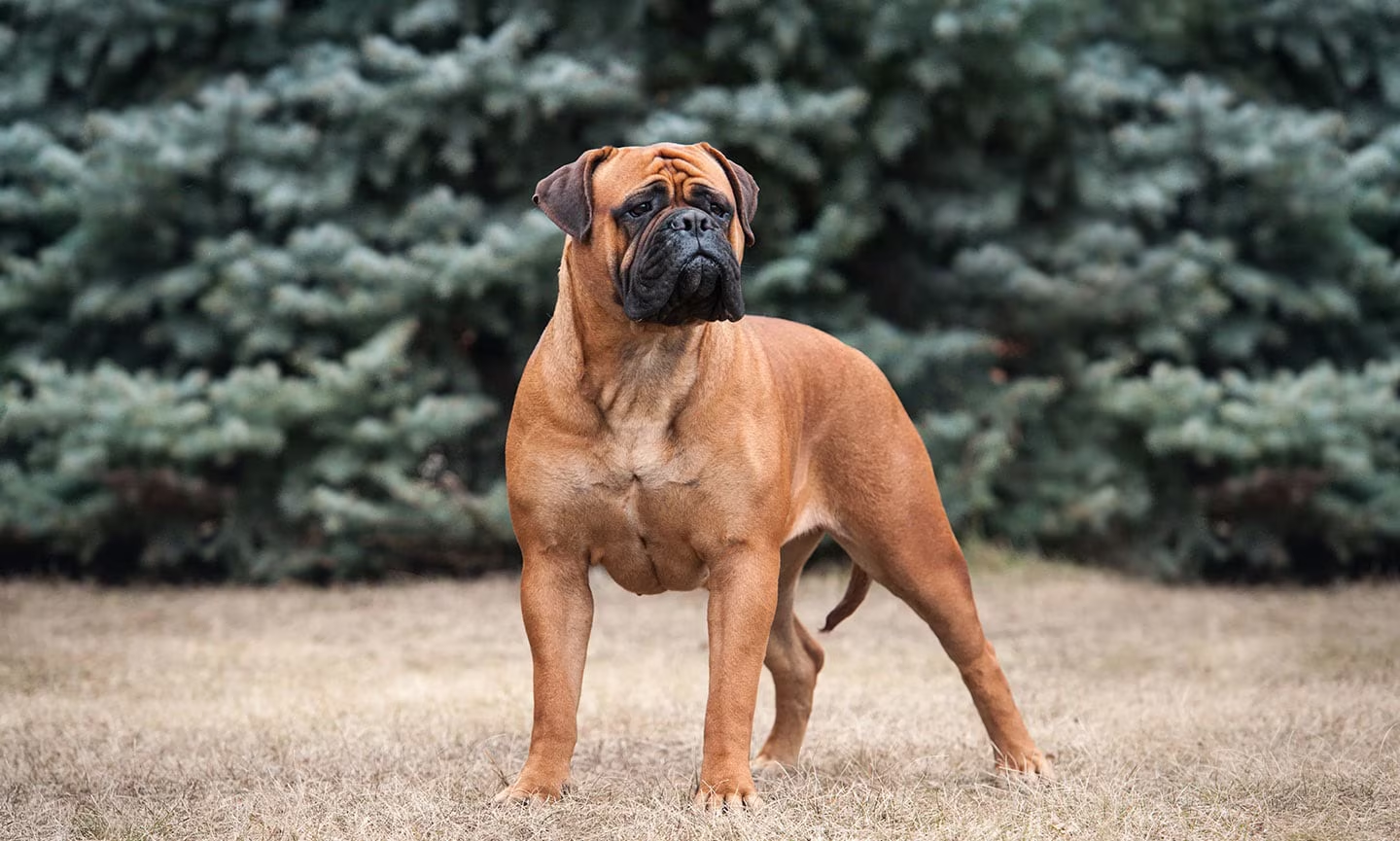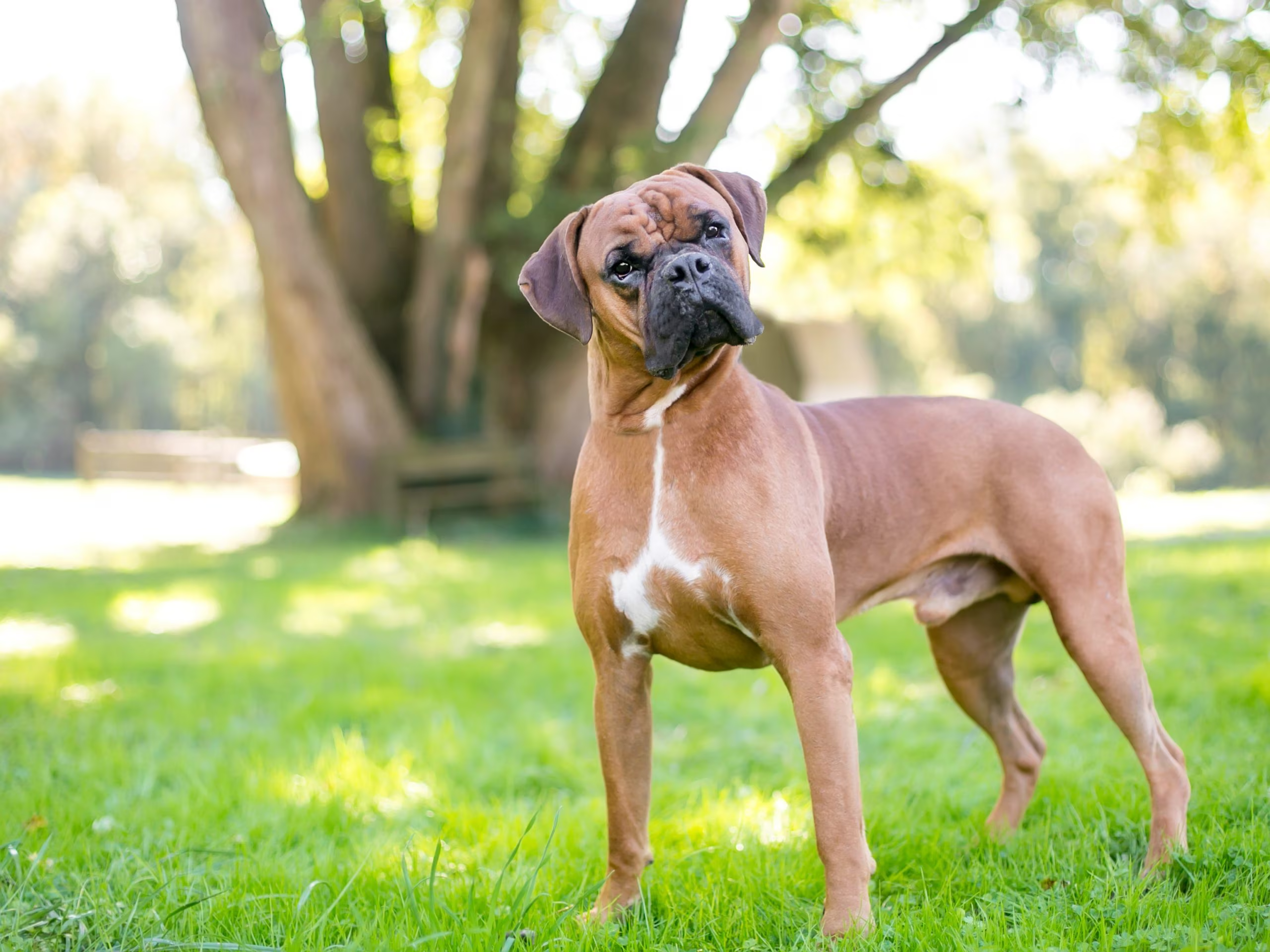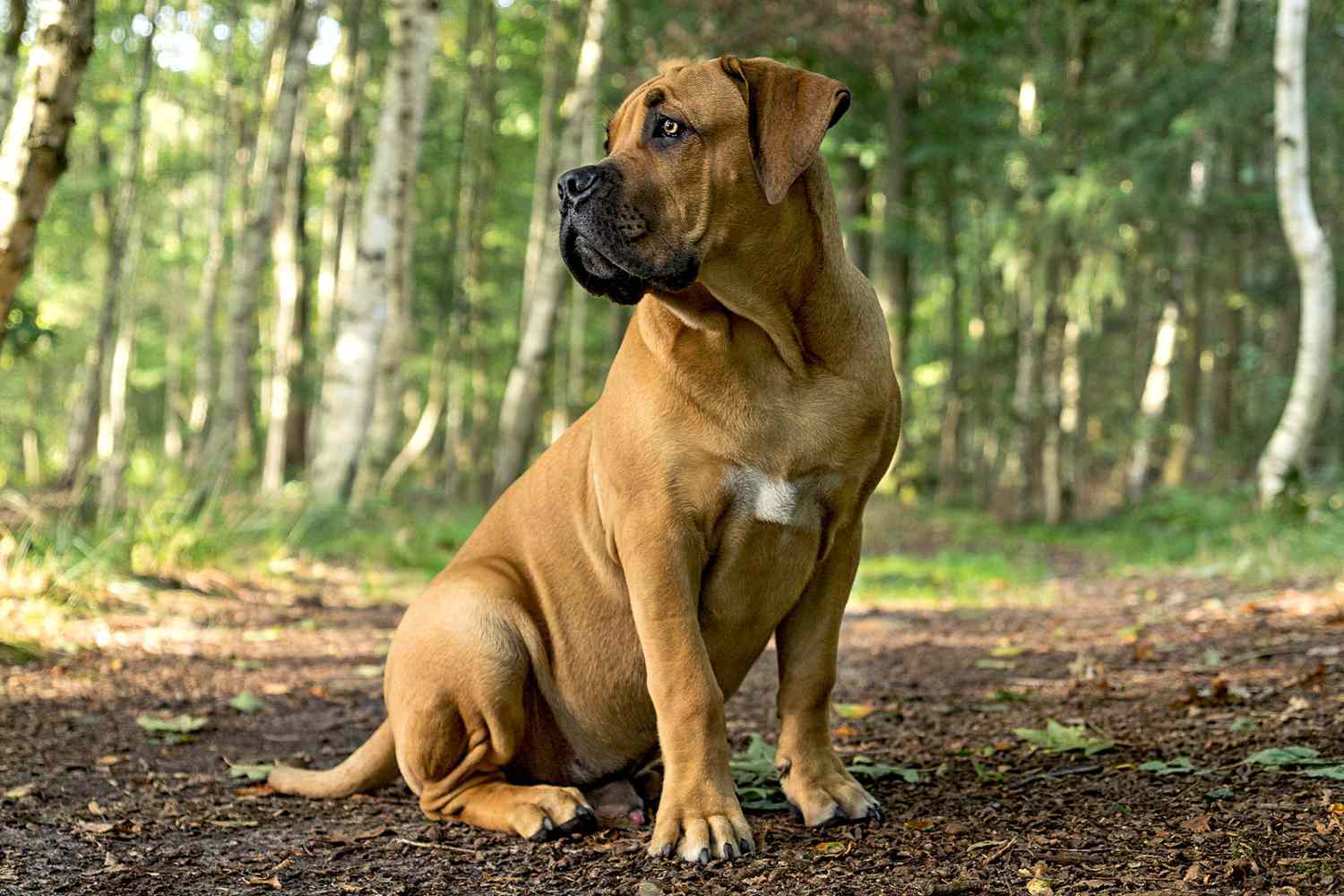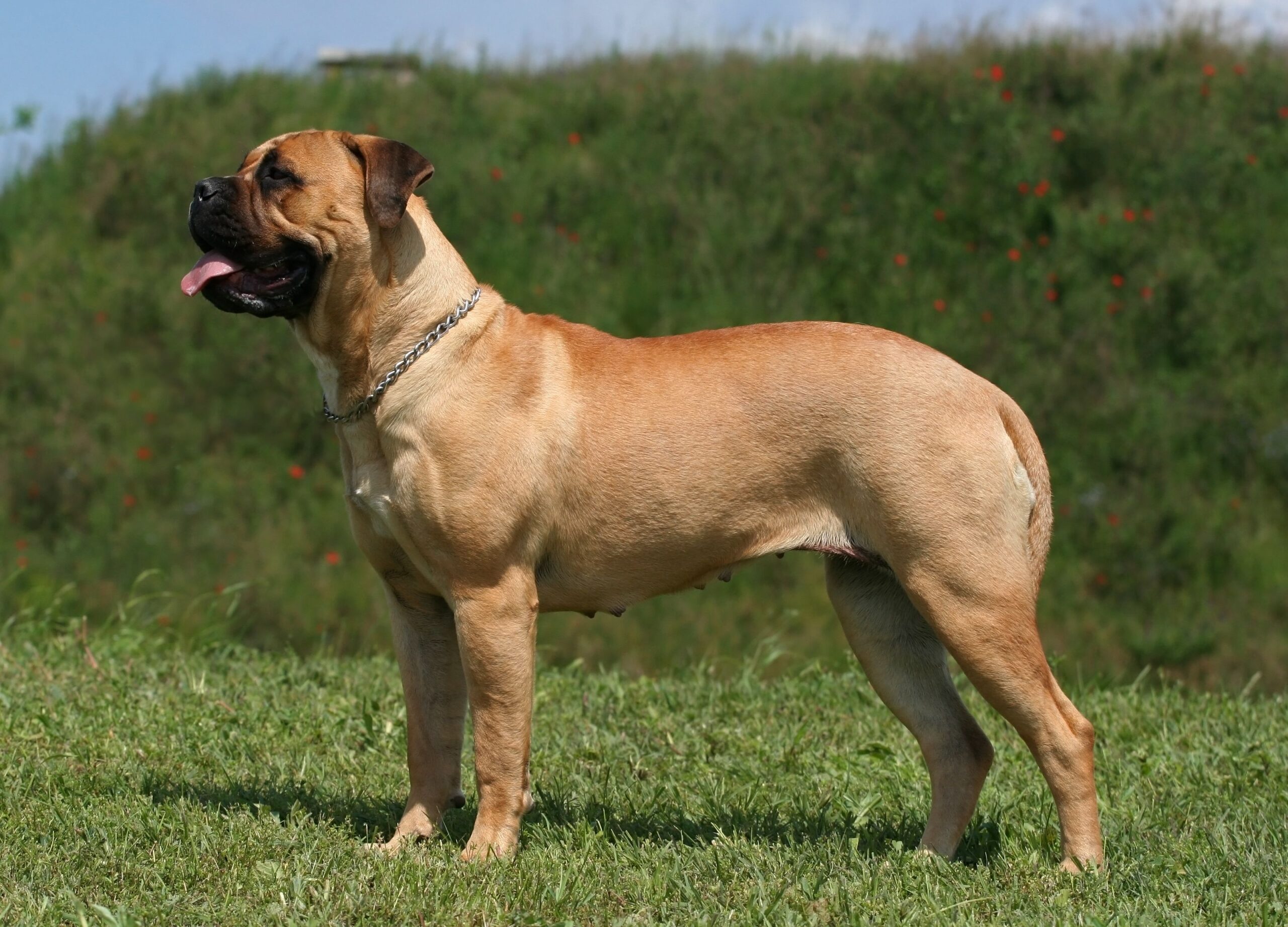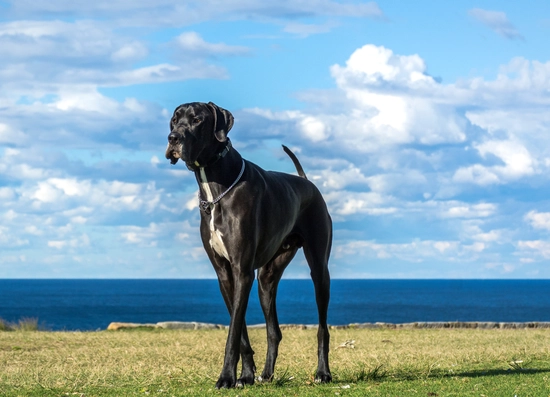The first time I locked eyes with a Bullmastiff, I was instantly captivated. There’s something undeniably magnetic about these powerful dogs with their massive heads, alert expressions, and impressive stature. Standing beside one feels like you’re in the presence of royalty—canine royalty that could probably bench press you, but would rather lean against your leg for pets instead.
If you’re considering adding one of these “gentle giants” to your family (or if you’re just fascinated by this remarkable breed), you’re in for a treat! I’ve spent years researching and interacting with Bullmastiffs, and I’m excited to share everything I’ve learned about these magnificent guardian dogs who’ve traded their poacher-catching days for couch-potato afternoons.
While their imposing appearance might initially seem intimidating (we’re talking about dogs that can weigh up to 130 pounds!), Bullmastiffs are known for their surprisingly sweet, docile nature with family. They’re living proof of the saying “don’t judge a book by its cover”—or in this case, don’t judge a dog by its massive jowls and muscular build. So grab your favorite beverage, maybe a drool rag (trust me, you’ll need it), and let’s dive into the wonderful world of Bullmastiffs!
The Fascinating History: From Gamekeeper’s Night Dogs to Family Companions
The Bullmastiff’s origin story is as intriguing as the breed itself, with roots firmly planted in the British countryside of the mid-19th century. Unlike many ancient breeds with thousands of years of history, the Bullmastiff is a relatively recent creation with a very specific purpose in mind.
Birth of the Breed: The Gamekeeper’s Night Dog
In 1860s England, poaching was a serious problem on large country estates. Gamekeepers needed a special kind of dog to help them catch these thieves—one that was quick, powerful, quiet, and controlled. The English Mastiff was too slow and heavy for the job, while the Bulldogs of that era (much larger and more aggressive than today’s versions) were too fierce and uncontrollable.
The solution? Create a new breed that combined the best of both worlds. By crossing these two British breeds in what’s often described as a 60% Mastiff and 40% Bulldog ratio, gamekeepers developed the perfect protector: the Bullmastiff. These dogs could silently track intruders through the darkness, quickly overtake them with surprising speed, knock them to the ground with their substantial weight, and then simply hold them down until the gamekeeper arrived—not mauling or severely injuring them.
This unique skill set earned them the nickname “Gamekeeper’s Night Dog,” and their stealthy abilities were so valued that the brindle coat color was initially preferred because it provided better camouflage in the darkness. They truly were the ninjas of the dog world!
From Working Dogs to Recognized Breed
As poaching became less common and estates began employing different security measures, Bullmastiffs transitioned from working dogs to companions and guardians of homes and businesses. Their proven protective abilities made them valuable in various settings—from guarding diamond mines in South Africa to protecting the Rockefeller estate in America.
The breed was officially recognized by The Kennel Club in England in 1924, with a requirement that dogs had to have at least four generations of pure Bullmastiff breeding without new infusions of either Bulldog or Mastiff. The American Kennel Club followed a decade later, officially recognizing the breed in 1934. Today’s Bullmastiff has retained the protective instincts and physical power of its ancestors, but centuries of careful breeding have emphasized their gentle, affectionate temperament with family.
Physical Characteristics: The Powerful Bullmastiff Look
The Bullmastiff’s appearance screams power and presence. These dogs command attention without making a sound—their physical attributes alone are enough to make most potential intruders think twice!
Size and Structure: Compact Powerhouses
Unlike their Mastiff cousins who can be somewhat lumbering, Bullmastiffs are more compact and athletic while still being impressively large. Males stand 25-27 inches at the shoulder and typically weigh between 110-130 pounds, while females are slightly smaller at 24-26 inches and 100-120 pounds. That’s still roughly the size of an adult human!
Their body structure is square and powerful, with a broad chest, strong shoulders, and muscular hindquarters that enable the quick bursts of speed that made them effective working dogs. Despite their bulk, well-bred Bullmastiffs move with surprising grace and agility—a living reminder of their history as dogs that needed to cover short distances quickly to apprehend poachers.
That Distinctive Head
A Bullmastiff’s head is perhaps their most defining feature—broad, square, and powerful with wrinkles that give them a somewhat pensive, serious expression. Their muzzle is shorter than a Mastiff’s (thanks to that Bulldog ancestry) but not extremely flat-faced. This gives them a distinctive profile that splits the difference between their parent breeds.
Their eyes are medium-sized and hazel to dark brown, set wide apart with an alert, intelligent expression that seems to miss nothing. Their ears are V-shaped, folded, and set high on the head, adding to their attentive appearance. When a Bullmastiff focuses on something of interest, that entire massive head turns with purpose, and you can practically see the wheels turning behind those watchful eyes.
Coat and Colors: Simple but Striking
Bullmastiffs sport a short, dense coat that lies close to the body, requiring minimal grooming while still providing protection from the elements. The breed standard recognizes three primary colors:
- Fawn: Varying from light tan to a deeper golden shade
- Red: A richer, reddish-brown color
- Brindle: Either a fawn or red base with dark stripes creating a tiger-like pattern
All Bullmastiffs should have a black mask on their muzzle that extends up to and around the eyes, creating a distinctive facial appearance. Small white markings on the chest are permitted but not preferred in show dogs (though they don’t affect the dog’s quality as a companion in the slightest!).
The Drool Factor: Keeping It Real
I’d be doing you a disservice if I didn’t mention that Bullmastiffs, like many breeds with loose jowls, are world-class droolers. After drinking water, during mealtimes, when they’re hot or excited—expect some slobber in your life if you welcome a Bullmastiff into your home.
Many Bullmastiff owners simply embrace this aspect of the breed, keeping “drool towels” strategically placed around the house and perhaps investing in some waterproof furniture covers. The drool comes with the territory—just consider it part of their charm! (And honestly, you do get used to it.)
Temperament and Personality: The Heart of a Guardian
While the Bullmastiff’s striking appearance might initially catch your eye, it’s their remarkable temperament that truly wins hearts. These dogs possess a unique combination of guardian instincts and gentle affection that makes them extraordinary companions for the right homes.
The Essence of Bullmastiff Temperament
If I had to describe Bullmastiff temperament in one phrase, it would be “fearless guardian with a heart of gold.” These dogs are the definition of a gentle giant—typically calm, affectionate, and surprisingly sensitive with their family members while remaining naturally protective and alert to potential threats.
Bullmastiffs form incredibly strong bonds with their people and are known for their unwavering loyalty. They’re not typically “velcro dogs” who need to be in constant physical contact, but they do prefer to be where their family is. You’ll often find your Bullmastiff quietly positioning themselves in a spot where they can keep an eye on everyone—perhaps lying in a doorway where they can monitor multiple rooms at once.
One quirky aspect of Bullmastiff behavior that always makes me smile is their tendency to lean against their favorite humans. This “leaning” is partly affection and partly just their way of saying “I’m here”—though at 120+ pounds, their presence is pretty hard to miss!
Protective Instincts: Born Guardians
Bullmastiffs were literally created to be guardians, and those instincts remain strong in today’s dogs. They have an innate ability to discern between normal situations and genuine threats, typically responding to the latter with alert watchfulness rather than aggressive barking.
Unlike some guardian breeds that are constantly on high alert, well-bred Bullmastiffs tend to be discerning and measured in their responses. They’re naturally wary of strangers but not typically fearful or aggressive without cause. Their intimidating size alone serves as a powerful deterrent, allowing them to protect simply by being present.
Interestingly, Bullmastiffs aren’t generally “barkers”—a trait that stems from their history as stealthy night dogs who needed to quietly approach poachers. When a Bullmastiff does bark, it usually means they’ve detected something truly concerning that deserves your attention.
Home Life: Surprisingly Chill Companions
Despite their working heritage and impressive physical capabilities, modern Bullmastiffs are remarkably low-key in the home. Adult Bullmastiffs are often described as “couch potatoes” who perfect the art of finding the most comfortable spot in the house and claiming it as their own.
This relatively low energy level makes them well-suited to less active families and even apartment living (provided they get proper daily walks and have enough indoor space to move around comfortably). They don’t need hours of intensive exercise to be content—moderate daily activity is typically sufficient for an adult Bullmastiff.
One of the most endearing quirks of the breed is their conviction that they’re lap dogs, despite all evidence to the contrary. Many Bullmastiff owners report their massive dogs attempting to curl up in their laps or at least resting their substantial heads there. It’s simultaneously hilarious and heart-melting to have a 120-pound dog convinced they’re the perfect size for cuddles!
With Children and Other Pets
Well-bred, properly socialized Bullmastiffs typically excel with children, showing remarkable gentleness and patience with kids in their family. They seem to instinctively understand their own strength and move carefully around smaller humans. That said, their sheer size means supervision is always necessary with young children—an excited Bullmastiff could accidentally knock over a small child just by turning around too quickly.
When it comes to other pets, Bullmastiffs can coexist peacefully with other animals when properly introduced and socialized, though some may have stronger prey drives toward very small animals. Some Bullmastiffs can display same-sex aggression with other dogs, so opposite-sex pairings often work better in multi-dog households.
Training and Socialization: Creating a Well-Mannered Bullmastiff
Training and socialization are absolutely crucial for Bullmastiffs. Given their size, strength, and protective instincts, a well-trained Bullmastiff is a joy to live with, while an untrained one can be challenging and potentially problematic.
Start Early: The Foundation of Good Behavior
Socialization should begin the moment your Bullmastiff puppy comes home and continue throughout adolescence. Expose your pup to a wide variety of people, places, animals, and situations during those crucial early months (8-16 weeks) when they’re most receptive to new experiences.
Focus particularly on positive encounters with diverse types of people—men, women, children, people wearing hats or uniforms, people using mobility aids, etc. This helps prevent your Bullmastiff from becoming unnecessarily suspicious of certain groups later in life. Well-structured puppy kindergarten classes can be fantastic for controlled socialization with other dogs and people.
Remember that socialization is an ongoing process, not a one-time event. Continue exposing your Bullmastiff to new experiences throughout their first few years to maintain their social skills and confidence.
Training Approach: Respect Their Intelligence
Bullmastiffs are intelligent dogs who learn quickly, but they can also be independent thinkers who sometimes question why they should perform certain tasks. This isn’t stubbornness so much as a characteristic of a breed developed to work somewhat autonomously.
These sensitive dogs respond best to positive reinforcement methods that reward desired behaviors rather than punishing mistakes. Harsh corrections or dominance-based training approaches typically backfire with Bullmastiffs, causing them to shut down or become resistant to training.
Consistency is key with this breed. Establish clear rules and boundaries from day one, and enforce them fairly but firmly. Bullmastiffs thrive with structured routines and clear expectations—they want to know what you want from them, even if they occasionally choose to test those boundaries!
Essential Skills for the Well-Mannered Bullmastiff
Given their size and protective instincts, certain training priorities take precedence with Bullmastiffs:
- Leash manners are absolutely critical—a 120-pound dog pulling on leash is not just annoying, it’s potentially dangerous
- Solid recall (coming when called) could be lifesaving in emergency situations
- Impulse control around exciting stimuli like visitors, food, or other animals
- “Place” or “go to your spot” commands help manage their presence in the home
- Appropriate door manners prevent bolting when visitors arrive
Basic obedience (sit, stay, down) forms the foundation for these more specialized skills and helps establish clear communication between you and your Bullmastiff. Begin training these essential commands as early as possible, keeping sessions short (5-10 minutes), positive, and engaging.
The Adolescent Challenge
Bullmastiff owners should prepare for the adolescent phase, typically between 6-18 months, when their formerly compliant puppy may suddenly test boundaries and “forget” previously mastered skills. This is normal developmental behavior, but it can be particularly challenging with a dog rapidly approaching adult size and strength!
During this phase, maintain consistent expectations while understanding that regression is normal. Keep training sessions positive but structured, and don’t hesitate to go back to basics if needed. Most Bullmastiffs mature into well-mannered adults by 2-3 years of age with consistent guidance throughout adolescence.
Health and Care: Keeping Your Bullmastiff Thriving
Like all purebred dogs, Bullmastiffs have specific health considerations and care requirements that prospective owners should understand. Proactive care and working with reputable breeders can help ensure your Bullmastiff lives the healthiest life possible.
Lifespan and Common Health Concerns
Bullmastiffs typically live 7-9 years, which is shorter than many smaller breeds but fairly typical for dogs of their size. While they’re generally robust dogs, they can be prone to certain health issues:
- Hip and elbow dysplasia (joint malformation that can lead to arthritis)
- Cardiac issues, including subaortic stenosis
- Progressive Retinal Atrophy (gradual vision loss)
- Entropion or ectropion (eyelid abnormalities)
- Bloat/gastric torsion (a life-threatening emergency where the stomach twists)
- Cancer (various types affect the breed)
Working with a reputable breeder who conducts appropriate health testing helps reduce the risk of inherited conditions. For owners of rescue Bullmastiffs with unknown backgrounds, establishing a good relationship with a veterinarian experienced with large breeds is especially important.
Nutrition: Feeding Your Gentle Giant
Proper nutrition is crucial for Bullmastiffs at all life stages. Puppies need a high-quality large-breed puppy formula that supports appropriate growth—too-rapid growth in large breeds can contribute to orthopedic problems down the road.
Adult Bullmastiffs typically do well on premium large-breed formulas that support joint health and weight management. Divide their daily food into at least two meals to reduce the risk of bloat, and avoid exercise immediately before and after eating.
Weight management is critically important. Extra pounds put tremendous stress on joints and internal organs, potentially shortening lifespan and reducing quality of life. You should be able to feel (but not prominently see) your Bullmastiff’s ribs, and they should have a visible waist when viewed from above.
Exercise Needs: Moderate But Essential
Despite their sometimes lazy reputation, Bullmastiffs do need regular exercise to maintain physical and mental health. For adult Bullmastiffs, 30-45 minutes of moderate activity daily is typically sufficient, with a focus on controlled, low-impact exercise rather than high-intensity activities that could stress their joints.
Exercise needs vary by age:
- Puppies (under 18 months): Short, multiple walks daily with plenty of rest; avoid stairs, slippery floors, and jumping
- Adults (2-5 years): Daily walks and moderate play sessions; some enjoy swimming as joint-friendly exercise
- Seniors (6+ years): Continued daily activity adjusted for comfort; shorter, more frequent walks
Remember that Bullmastiffs can be sensitive to heat due to their size and relatively short muzzles. Exercise during cooler parts of the day and always provide access to fresh water and shade.
Grooming: Minimal But Necessary
The Bullmastiff’s short coat is relatively low-maintenance, requiring just weekly brushing with a rubber curry brush or grooming mitt to remove dead hair and distribute skin oils. They do shed, with seasonal increases typically in spring and fall.
Bathing can be limited to every 6-8 weeks unless they get particularly dirty. More frequent bathing can strip natural oils and lead to skin issues. Use a gentle dog shampoo formulated for sensitive skin.
Other important grooming tasks include:
- Cleaning facial wrinkles weekly to prevent infection (baby wipes work well, followed by thorough drying)
- Checking and cleaning ears weekly
- Trimming nails every 3-4 weeks
- Brushing teeth regularly for dental health
And yes, “drool management” definitely counts as grooming for this breed! Keep soft cloths handy for wiping jowls after drinking or during excited moments.
Living With a Bullmastiff: Practical Considerations
Before bringing home a Bullmastiff, there are practical aspects of daily life with these impressive dogs that deserve careful consideration. From housing needs to financial planning, understanding what it really means to share your home with a dog of this size helps ensure a successful match.
Space Requirements: Room to Maneuver
While Bullmastiffs don’t need acres of running space, they do need room to move comfortably inside your home. Their substantial size means they take up significant floor space whether lounging in the living room or navigating hallways. Tight spaces and steep stairs can be challenging for these large dogs to manage, especially as they age.
Outdoor space is beneficial but not mandatory. A securely fenced yard provides a safe area for exercise and bathroom breaks, but many urban Bullmastiffs thrive with regular walks and no private yard. If you do have a fence, make sure it’s sturdy and at least 6 feet tall—while not typically jumpers, a determined Bullmastiff can clear or break through inadequate fencing.
Vehicle considerations are important too—transporting a full-grown Bullmastiff requires a larger vehicle with accessibility features for a dog who may weigh more than most humans!
Family Compatibility: Is a Bullmastiff Right for You?
Bullmastiffs can thrive in various household setups, but they’re not the right fit for everyone. They typically do best with:
- Families who spend significant time at home (they bond closely and don’t do well with long periods alone)
- Experienced dog owners who understand positive training methods
- Households with older children who can interact appropriately with a large dog
- People who appreciate a loyal guardian with moderate exercise needs
- Those who aren’t overly concerned about drool, shedding, or having personal space
They may not be ideal for:
- First-time dog owners who might struggle with the training needs
- Very active families seeking a running or hiking companion
- Households with very young, unsteady toddlers (due solely to the risk of accidental bumping)
- Those living in housing with weight or breed restrictions
- People who are physically unable to manage a large dog in an emergency
The Financial Reality: Budgeting for Your Bullmastiff
Big dogs come with bigger expenses. Prospective Bullmastiff owners should prepare for costs that often exceed those of average-sized breeds:
- Quality food: $80-150+ monthly for premium large-breed formulas
- Preventative medications: Flea/tick and heartworm medications are typically dosed by weight, meaning higher costs
- Veterinary care: Procedures often cost more due to increased anesthesia requirements and medication dosages
- Supplies: Larger beds, crates, collars, and other accessories all come with premium pricing
- Training: Professional training may be necessary, especially for first-time owners of guardian breeds
Pet insurance is worth considering for Bullmastiff owners, as emergency veterinary care for a dog of this size can quickly become extremely expensive.
Finding Your Bullmastiff: Adoption and Purchasing Options
If you’ve decided a Bullmastiff is the right breed for you, the next step is finding your perfect match. Whether you choose to adopt or purchase from a breeder, doing your research is crucial.
Rescue and Adoption
Surprisingly, purebred Bullmastiffs do end up in rescue situations. Breed-specific rescues exist throughout the country, focusing exclusively on finding homes for Bullmastiffs and Bullmastiff mixes. General shelters sometimes have them as well, though they may be labeled simply as “large mixed breed” dogs.
Adoption advantages include:
- Lower initial cost (typically $300-600 adoption fee)
- Often already spayed/neutered with initial vaccinations
- Many are already adults with established personalities
- The satisfaction of providing a loving home to a dog in need
When adopting, be prepared to discuss your living situation, experience with dogs, and how you plan to care for a giant breed. Good rescues want to ensure their dogs go to appropriate, permanent homes.
Responsible Breeders
If you decide to purchase a Bullmastiff puppy, finding a responsible breeder is absolutely essential. Ethical Bullmastiff breeders are focused on health, temperament, and breed preservation rather than profit.
Signs of a responsible breeder include:
- Health testing of breeding stock for conditions common in Bullmastiffs (hip/elbow evaluations, cardiac screening, eye testing)
- Raising puppies in a home environment with early socialization
- Limited breeding frequency for female dogs
- Knowledgeable about the breed and willing to educate new owners
- Careful screening of potential buyers and willingness to take dogs back if needed
- Ongoing support and guidance throughout the dog’s life
Expect to pay $1,500-3,000 for a well-bred Bullmastiff puppy from health-tested parents. While this may seem expensive, it’s an investment in a healthier dog and potentially fewer medical issues down the road.
Red Flags to Avoid
Whether adopting or purchasing, watch for these warning signs:
- Anyone breeding “rare” colors not standard for Bullmastiffs
- Claims of “extra-large” Bullmastiffs far exceeding breed standards
- Multiple litters available at once or always having puppies available
- Unwillingness to show you the puppies’ living conditions or meet the mother
- No health testing or guarantees
- Pressure to decide quickly without asking questions
Taking your time and being selective is important when acquiring any dog, but particularly crucial with a breed as large and powerful as the Bullmastiff.
Conclusion: Is a Bullmastiff Your Perfect Match?
After spending time with these magnificent dogs and their devoted owners, I’ve come to believe that Bullmastiffs are truly special companions for the right homes. They offer an unmatched combination of imposing protective presence and gentle, affectionate temperament that makes them uniquely suited to being both guardians and loving family members.
These aren’t dogs for everyone—they drool, they shed, they take up half your couch, and they require consistent training and socialization to be their best selves. But for those who appreciate their blend of protective instincts and loving nature, Bullmastiffs offer incomparable companionship and loyalty.
If you have the space in your home and heart for one of these powerful yet gentle guardians, if you value loyalty and quiet watchfulness over endless energy and athleticism, and if you’re prepared for the financial and practical realities of giant breed ownership, a Bullmastiff might just be your perfect match.
Just be warned—once you’ve experienced life with a Bullmastiff leaning contentedly against your leg or attempting to be a lap dog despite all evidence to the contrary, it’s hard to imagine life without one of these magnificent guardians with hearts of gold watching over you and your family.
TAGS: Meta Description:
